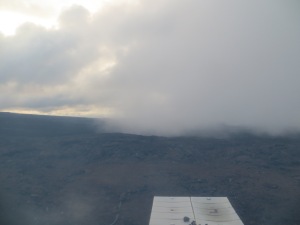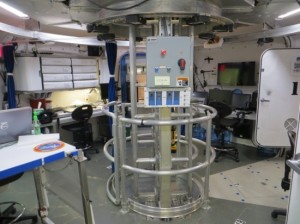Give me the splendid silent sun with all his beams full-dazzling.
– Walt Whitman, first line of poem “Give Me the Splendid Sun”.
For today’s post, I’d like to springboard a bit from my crewmate Shey’s recent blog post. In her article, she explores an interesting question: if humans have a need to retreat underground in order to survive on other worlds, will they be able to cope with the absence of sunlight? I’d like to think about that briefly too. Will astronauts need to see the Sun? Or are there tricks we can play in its absence?
Shey mentioned our HERA mission in April, which simulated a journey through interplanetary space to an asteroid. In the space between the planets, there is no true day or night, there is only the direction you choose to point your spacecraft’s windows. With no sunlight, and little variation in light levels throughout the day, the experience was a bit disorienting at first. On one of the first days of the mission, I completed what I thought was a mid-afternoon MMSEV sim session…only to look at the clock at on the wall, and discover that it was actually 7pm in the evening! Though initially confusing, I quickly learned to keep a close eye on my wristwatch, to keep myself oriented to the time of day. I was able to adapt to the lack of sunlight, at least for the brief two weeks of the mission.
Sometimes, the presence of the Sun, rather than its absence, can be the source of disorientation. Prior to HI-SEAS IV, I worked in the Mission Support Area at Lockheed Martin, controlling NASA interplanetary spacecraft. Robotic space probes tend to be automated to largely take care of themselves, and our need for 24/7 coverage was limited to special events, such as launches or planetary arrivals. For us Real-Time Operators, or “ACEs” – the folks in the MSA whose job is to communicate directly with the spacecraft – our standard night shifts on these occasions typically run from 6pm to 6am.
My first set of night shifts were in support of the Jupiter-bound Juno spacecraft, just after launch. I found that I was fine for most of the evening, almost convincing myself that the clock on the wall that read “10pm” was really showing “10am”. But, around 4 or 5am, the first rays of morning sunlight would begin to filter in through the MSA windows, and the illusion would be shattered. My brain would realize the absurdity of the situation – “That’s sunrise! You’ve been up all night! Go to sleep now!” – and fatigue would set in almost immediately.
My second set of night shifts came later in the year, just after the launch of GRAIL. Since it was planned to be such a short mission, and since the main MSA was already packed full – four sets of active spacecraft consoles in one control room – mission control for the twin Lunar orbiters remained in the pre-launch Test Control Center, a windowless room on the floor above the MSA. It was the perfect setup for a night shift: with no windows to let in the sunlight, I could trick my brain into thinking it was whatever time I needed it to be.

One of the weather phenomena that caught my eye: the edge of a cloud slowly moving in. The rock is still sitting undisturbed on top of the tank.
Speaking of windows, what of the window in our habitat? For sure, I do find it quite useful, especially for tracking the weather affecting our solar panels and EVAs – as one aviation saying goes, “one peek is worth a thousand radar sweeps” – and a passing weather phenomenon will sometimes grab my interest. But, at the same time, the view is tauntingly static. The same view of the top of the grey-water tanks and evaporation field, the same red rock perched comfortably on top of the left tank (I’ve considered shifting the rock while on one of my EVAs to add a little variety). No neighbors coming and going, little variation in the landscape apart from the technological tendrils of our habitat grasping to the unforgiving ground, mostly just rocks and sky. Forever unchanging, the window can sometimes seem less like a view of the outside world, and more like a painting on the wall.
Fortunately, we are lucky enough to live above ground here at HI-SEAS. While the view is unchanging, a glimpse out of the window can at least tell us the time of day. Sunlight also illuminates the walls of our dome, giving a bit of a natural glow to our common area in daylight. Though a day on Mars is about 24.5 hours long, our mission runs on Earth time – the Sun’s influence is strong enough here that a 24.5 hour clock just wouldn’t be believable.
Ultimately, what do I think will help astronauts to deal with a lack of sunlight? Simple perseverance. It’s what I believe drives Navy submariners and scientists working in Antarctica, people who routinely live for months at a time without seeing the Sun. It’s what I believe drives NASA rover controllers living on Earth but following Mars time, where the half-hour in the difference in the length of each planet’s day causes the Sun and the controllers’ perception of time to slowly drift into maddening opposition and back again. And it’s what I believe drives astronauts aboard the ISS, who experience sixteen sunrises and sunsets every single “day” on orbit.
So, will humans be able to live underground on other worlds, deprived of the light of the Sun? Perhaps the folks already living in the darkness – the submariners and the Antarctic researchers – give an indication that it could be possible. Perhaps the HERA missions – increasing to a month in length in 2016, and aiming for two months per mission in 2017 – will give more answers. But, as long as there are people with the drive to face the hardships inherent in exploration, I’m optimistic of our chances.

I did not realize that the astronauts aboard the ISS were seeing 16 times more sunrises and sunsets than myself. I knew that shuttle crews had seen more sunrises and sunsets on a daily basis, but for a much shorter time span than on the ISS. It made me wonder if the perception of time on the ISS was distorted. Do those astronauts feel like they have been in orbit for years on end? It was just a thought triggered by your blog. Thanks, I enjoy your entries.
LikeLike
Thanks Robert, and great question! Coincidentally, I just finished reading “An Astronaut’s Guide to Life on Earth” by Chris Hadfield a couple of nights ago. He answers some frequently-asked questions at the end of the book, and actually talks about this. He calls the 16 sunrises and sunsets “a bizarre and beautiful new reality”, and talked about how it became something of a pleasant ritual for him to turn off the station lights and cover the windows at “night” so the crew could sleep, and turn them on again for everyone in the “morning”.
LikeLike
I spent 13 months on DGar. There were some similarities to what you describe here. We had odd schedules that would leave us with a few night shifts in a row. Being close to the equator, the day/night cycle was pretty consistent. We did 12 ons/12 offs starting at 6. We would blackout our rooms for the times we needed to sleep during the day. We could go days without seeing the sun.
I am not sure we encountered a scenario in which we felt needs based on light. We were definitely more aware of the clock. We just did what we were supposed to do. I think if you are of a certain mindset, one that wants to complete a task, you make the proper adjustments and move on. Persevere is the way you put it.
We did sometimes have to drag out of bed, at what was relatively the middle of the night, for barbecues and the like. Nobody threw those at 2am.
LikeLike
Hey there Justin!
I’d suspected that was the sort of mindset, but it’s good to hear more from someone who’s actually done it. Thanks for adding your perspective!
LikeLike